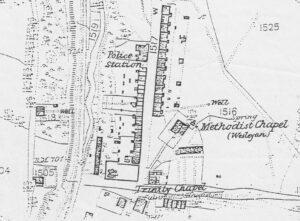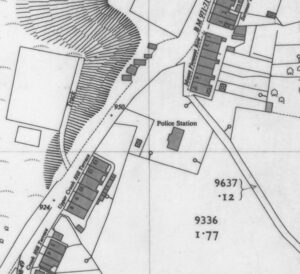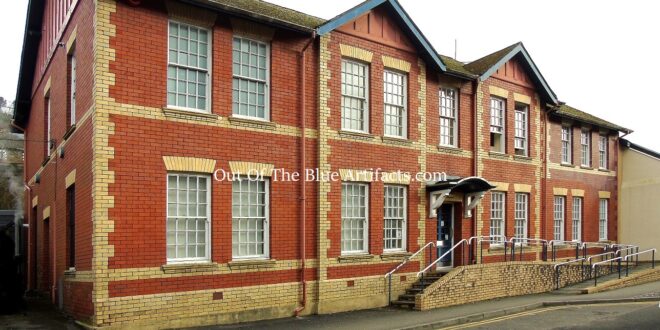Abertillery Police Stations and Court Houses.
In the mid 19th century, the main police station, the County Constabulary was at Blaina. There were police officers operating in Abertillery at this time though they were not based in a station, they seemed to have been using either their own home or residing in police houses in the town.
Policeman Mr Samuel Addison.
On Monday 2nd of September 1849, one of the first reports of a policeman in this area was Policeman Mr Samuel Addison, Mr Addison was at the White Horse Tavern, Cwmtillery and accidentally shot the landlord Mr Daniel Jones in the arm with a six-barrelled pistol. I don’t know if Mr Addison was based here, Blaenavon or Blaenserchan, the White Horse Tavern was close to the main drover’s route to both places in those days and quite a few pit sinkers who sunk the Tillery Colliery in the late 1840’s came from Pontypool so the White Horse Tavern was a busy place at this time.
The Magistrates Court.
In the 1850’s the magistrates at Abertillery under the chairmanship of Mr J. Conway (Tin Works proprietor) held court in the Odd Fellows Arms close to the tin works (where the Abertillery Fire Station is today).
Mr Charles Banfield.
In 1853 Mr Charles Banfield (Police Officer) was patrolling at Six Bells at the time a railway accident occurred. He was in all the reports and inquests but no mention of where he was based.
Mr Charles J. Haysom.
All records show that the first resident police officer in Abertillery was Mr Charles J. Haysom, he and his wife Mary Ann Haysom nee Starks, lived in Abertillery in the 1860’s and he attended many scenes of crime, sometimes his wife accompanied him when anyone needed aid or comforting. Later Mr Haysom was reported as being employed as the tin works security policeman in Abertillery. The collieries also had their own police, sometimes the officers were contracted to the colliery by the constabulary and paid for by the coal owners.
The First Police Station.
In 1871 the census shows that there was a police station on Market Street, Abertillery. It was situated as being adjacent to the Commercial Hotel and a few premises away from the Top Bell Inn. It looks as though it was where the Market Hall would later be built.
Mr Patrick Fleming.
The 1871 census states Mr Patrick Fleming a police constable aged 31 years old was in charge and living there with his wife Mrs Mary Ann Fleming aged 30. Mr Fleming was from Ireland and his wife from Cheltenham, Gloucester, they had been in Abertillery since 1869.
P.C.s O’Donnell and Cosh.
In 1875 P.C. O’Donnell and P.C. Cosh were reported as being on duty in the town, though again I don’t know if they were actually based in Abertillery or Blaina, though the new information suggest they may have been stationed in Abertillery .
 The Second Police Station.
The Second Police Station.
Up until this point Abertillery wasn’t well populated and all Police work was organised from the County Constabulary in Blaina. As stated (above), there was some sort of police station on Market Street, Abertillery in the early 1870’s. A report on the need for a police station at Abertillery was put to the County Police Committee. The committee agreed to this and set out terms on financing and purchasing land to build a new police station. The committee arranged to lease ground at Wesleyan Road, Abertillery, later to be re-named Tillery Street. It was built on land rented from the Brynmawr Coal & Iron Company at £2. 13s. 6d. per annum and to be built at an estimated cost of £1,200.
The Brynmawr Coal & Iron Co.
The Brynmawr Coal & Iron Co was set up by Mr Basil Jayne to purchase the Tillery Colliery from his father Mr John Jayne in 1873. They owned the land until Mr T. W. Powell took over the Tillery collieries in 1882.
On Friday 15th of March 1878, tenders were invited for the building of the new purpose-built Police Station at Abertillery. Tenders to be sent to Mr Charles B. Fox, clerk of the police.
On Friday 22nd March 1878, a meeting of the County Police Committee took place at Usk, those present were as follows – Mr S. R. Bosenquet Esq (Chairman); Mr A. D. Berrington Esq; Mr J. C. Hill Esq; Mr C. J. Parkes Esq; Mr Basil Jayne Esq and Mr John James Esq: The committee gave the go ahead for the new station at Abertillery and accepted the tender of Messrs D. J. and D. Davies of Cardiff at a cost of £1,180. The population of Abertillery at this time was 6,000.
The Contractor and Architect.
The contractor for the new police station at Tillery Street, Abertillery were Messrs D. J. and D. Davies of Cardiff
The Telephone Connection.
In April 1898 the Monmouthshire Standing Joint Committee at Newport decided to connect the Police Station at Abertillery to the Telephone Exchange.
The Old Reading Rooms.
In 1882 Mr T. W. Powell took over the Tillery Collieries from Mr Basil Jayne and in 1884 he built a library and reading rooms at Tillery Street. In 1898 the Powell’s Company had the new Powell’s Tillery Institute built at Division Street, Abertillery. The old reading rooms were abandoned.
On Wednesday 7th of August 1895, at a meeting of the Monmouthshire County Council a letter was read from Mr Samuel Nathan Jones of Abertillery, to inspect the old Powell’s Tillery Reading Rooms, left abandoned near the Abertillery Police Station on Tillery Street, in view of the proposal to purchase the building to use as a courthouse. Later the Powell’s Steam Coal Company built the new Powell’s Tillery Institute and sold their old Reading Rooms for £1,000 and the construction of a courthouse next to the police station went ahead.
The Abertillery Court House at Tillery Street.
In January 1899 the Abertillery Court House was completed. The work was carried out by Contractor Mr W. Smith under the supervision of County Surveyor Mr W. Tanner and was officially opened by Mr Samuel Nathan Jones, the other magistrates in attendance were as follows – Mr Colonel G. W. Wilkinson (Risca); Mr E. J. Williams; Mr Titus Phillips; Mr T. P. White; Mr J. Wallace; Mr Evan Phillips; Mr John Dakers; Mr J. Phillips and Mr W. Steadman: The following officials were also present – Mr E. H. Davies (Clerk); Mr Fowler (Deputy Clerk, Tredegar and Acting Superintendent Porter); Mr L. E. Webb (Solicitor) and Mr John Davies (School Attendance Officer):
The Contractor and Architect.
The contractor of the new Abertillery Court House on Tillery Street was Mr W. Smith. The architect was Mr W. Tanner.
The New Abertillery Police Station Proposal.
At the turn of the century the Abertillery Police Station on Tillery Street was getting too small for purpose, with the growing population a new much larger station and integrated courthouse was needed. In October 1901 tenders were invited for the building of a new station and courthouse to be erected on Somerset Street, in Abertillery.
On Wednesday 9th of October 1901, at a meeting of the Monmouthshire Standing Joint Committee, the tender of Messrs D. W. Richards at a cost of £4,400 was accepted for the construction of the new Abertillery Police Station and Court House.
On Tuesday 27th of May 1902, Mr Bosenquet (Chief Constable of Monmouthshire) came to Abertillery, he inspected the old station and all the book work. He stated that there were 3 sergeants and 19 constables based at the Tillery Street Police Station. The population of Abertillery at this time had risen to 21,955.
The New Station.
On Wednesday 18th of February 1903, the new Abertillery Police Station (as seen in the featured image above) and Abertillery Court House were opened. The selection of the site was not an easy one, the preferred site had already been let (though I don’t know where this was?) so the site between Cwm Street and Queen Street was chosen and the ground secured for a Headquarters Station and a Court House. The contract of Messrs D. W. Richards of Newport was carried out in a satisfactory manner and the final cost was £5,000. The site was on a hill in an awkward position fronting two streets parallel to one another. The frontage to Cwm Street was 90 feet and to Queen Street being 120 feet. The depth between the streets was 150 feet and the rise from Cwm Street to Queen Street being 36′ feet.
As of these difficulties, the station was built in two blocks, that fronting the Cwm Street consisting of the police station, entrance, charge office 3 cells, constables day room and offices with accommodation for ten single constables, a superintendent’s office, married sergeant’s quarters, consisting of a parlour, living room, scullery etc and three bedrooms. The quarters in each instance were private connected inside by doors having separate entrances.
The frontage to Queen Street has a house for the superintendent, comprising a parlour, living room, kitchen and offices, with four bedrooms and a bathroom. On this elevation was the courthouse 37′ feet by 22′ feet, retiring rooms for the justices and witnesses. Separate entrances were provided for the public, police and prisoners, the latter being brought from the cells from the lower section via a flight of stone steps.
The actual buildings were built of 16″ inch hollow brickwork, the red face bricks used were produced at the Star Brick Works at Risca, Monmouthshire and the buff face bricks were from the Ebbw Vale Works. The cells were constructed in double thickness in accordance with Home Office regulations. The buildings were heated by hot water, the heating contract being carried out by Mr Perman of Newport. The buildings were designed by Mr William Tanner F.S.I. County Surveyor and erected under his supervision.
The Contractor and Architect.
The contractor of the new station was Messrs D. W. Richards of Newport. The architect was Mr William Tanner F.S.I. the county surveyor.
The Formal Opening.
There was no formal opening but previous to commencing the business of the courts the magistrates inspected the building and expressed themselves as being thoroughly satisfied with what had been provided. Presiding Magistrate Mr J. Green of Blackwood was the chairman. The other magistrates on the bench were as follows – Mr Samuel Nathan Jones; Mr E. J. Williams; Mr T. B. White; Mr T. Phillips; Mr W. Stewart; Mr T. Vatchell; Mr J. Richards; Mr G. Padfield and Mr J. Davies:
The First Court Cases.
The very first ten cases heard on this opening day ranged from – The theft of a pigeon, stealing coal, wife desertion, slaughterhouse nuisance, a stable nuisance, family assault case, street fighting, bad language, disorderly conduct and obstruction. After the first batch of cases the magistrates retired for lunch at the Cwm Hotel served by the landlord Mr Judd. The following gentlemen were also present at the luncheon – Mr W. B. Harrison; Mr J. A. Shepard; Mr E. H. Davies; Mr V. Bosanquet; Mr J. Lewis; Mr William Tanner; Mr A. H. Dolman; Mr J. E. Phillips; Alderman Bowen; Inspector James; Messrs Francis Perman and W Richards:
 Later a police station was opened at Cwmtillery (as seen on the map right) It was built on the aptly named Crook Hill and housed a few police constables over the years, though I believe it ceased being a station in the 1970’s.
Later a police station was opened at Cwmtillery (as seen on the map right) It was built on the aptly named Crook Hill and housed a few police constables over the years, though I believe it ceased being a station in the 1970’s.
The Renovation of the Police Station.
Towards the end of 1995 the Abertillery Police Station on Somerset Street was in the process of being renovated and updated to meet requirements. Barclays Bank building at High Street, Abertillery had recently closed as the bank relocated to newer premises at Church Street, Abertillery.
Barclays Bank Building.
On Sunday 7th of January 1996 the police moved into and used the old bank premises as a temporary police station until the renovations at the main station on Somerset Street were completed.
The Later Years.
From about 2010 the Abertillery Police were restructured, the Police Station at Somerset Street was used on a part time basis.
The Closure of the Police Station.
In about 2017 the Abertillery Police Station at Somerset Street closed and was later sold, it was converted into self contained flats and is now used as an H.M.O.
The Ambulance and Police Services Building.
On Saturday 18th of February 2017, the Ambulance and Police Services moved into the Abertillery Fire Station at Station Hill to share the same building.
 Out Of The Blue Artifacts A Library of a lifetime of collecting
Out Of The Blue Artifacts A Library of a lifetime of collecting
